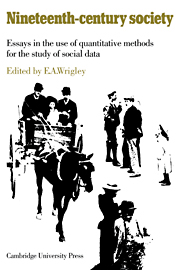Book contents
- Frontmatter
- Contributors
- Contents
- Introduction
- 1 The census, 1801–1891
- 2 The study of family structure
- 3 Sources of inaccuracy in the 1851 and 1861 censuses
- 4 Standard tabulation procedures for the census enumerators' books 1851–1891
- 5 Sampling in historical research
- 6 The use of information about occupation
- 7 The use of published census data in migration studies
- 8 Criminal statistics and their interpretation
- 9 The incidence of education in mid-century
- Notes
- Bibliography
- Index
Introduction
Published online by Cambridge University Press: 05 November 2011
- Frontmatter
- Contributors
- Contents
- Introduction
- 1 The census, 1801–1891
- 2 The study of family structure
- 3 Sources of inaccuracy in the 1851 and 1861 censuses
- 4 Standard tabulation procedures for the census enumerators' books 1851–1891
- 5 Sampling in historical research
- 6 The use of information about occupation
- 7 The use of published census data in migration studies
- 8 Criminal statistics and their interpretation
- 9 The incidence of education in mid-century
- Notes
- Bibliography
- Index
Summary
During the nineteenth century the state became involved in gathering more and more information about its subjects. To the traditional interests in trade, taxable wealth, religious schismatics and war potential, were added many new interests which resulted in immense compilations of data. Some of these were eventually tabulated and published, though far more were not. Even the material which was published was so bulky that it is seldom consulted. Anyone, for example, who has worked with the hundreds of heavy volumes of the Statistik des Deutschen Reichs and other similar series produced by the Statistical Office in Berlin must occasionally have felt his spirits droop at their oppressive combined mass. And in all economically advanced countries the trend was similar. Because so much information was collected by the state during the course of the last century, there are great opportunities for studying nineteenth-century society in depth, but also special difficulties in doing so.
The main focus of attention in this book is the census – what information was required on census night; how the information was collected; how accurately and completely population characteristics were recorded; the problems which arise in attempting to use either the published census volumes or the enumerators' books; and the techniques which have proved useful in analysis.
- Type
- Chapter
- Information
- Nineteenth Century Society , pp. 1 - 6Publisher: Cambridge University PressPrint publication year: 1972
- 1
- Cited by



